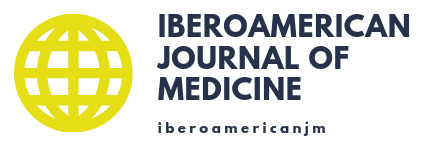A Rare Case of Botulism in an Adult Patient
Un caso raro de botulismo en una paciente adulta
Deyna Montes-Velez, William Bautista, Samantha Brophy, Justin Chatten-Brown, Leonard Ranasinghe
Abstract
Presentation of botulism in adults is extremely rare and symptoms can be easily confused for symptoms of acute stroke, Guillain-Barre, or myasthenia gravis. The purpose of this clinical case report is to ensure adult botulism will be included in the differential diagnoses for a patient with this presentation so swift and accurate care can be provided to ensure optimal patient outcome. A 41-year-old-female presented with complaints of sudden onset of difficulty speaking. The patient reports a history of intravenous polysubstance abuse and symptoms progressed to bilateral facial weakness, ptosis, and external ophthalmoplegia. With no notable findings from a non-contrast computed tomography and magnetic resonance imaging and given the symptoms, a diagnosis of wound botulism from intravenous drug use was made. Botulism antitoxin was given and the patient was admitted into the intensive care unit for supportive follow-up care. A colony of Clostridium species was discovered in this patient’s arm and the patient showed significant improvement after a few days of care.
Keywords
Resumen
La presentación del botulismo en adultos es extremadamente rara y los síntomas pueden confundirse fácilmente con los síntomas de accidente cerebrovascular agudo, Guillain-Barré o miastenia gravis. El propósito de este informe de caso clínico es garantizar que el botulismo del adulto se incluya en los diagnósticos diferenciales de un paciente con esta presentación, de modo que se pueda brindar una atención rápida y precisa para garantizar un resultado óptimo del paciente. Una mujer de 41 años presentó quejas de aparición repentina de dificultad para hablar. El paciente refiere antecedentes de abuso de múltiples sustancias por vía intravenosa y los síntomas progresaron a debilidad facial bilateral, ptosis y oftalmoplejía externa. Sin hallazgos destacables de la tomografía computarizada sin contraste y la resonancia magnética y ante la sintomatología, se realizó el diagnóstico de botulismo de la herida por uso de drogas intravenosas. Se le administró antitoxina de botulismo y la paciente fue ingresada en la unidad de cuidados intensivos para cuidados de seguimiento de apoyo. Se descubrió una colonia de especies de Clostridium en el brazo de esta paciente, mostrando una mejoría significativa después de unos días de atención.
Palabras clave
References
1. Berkowitz AL. Tetanus, Botulism, and Diphtheria. Continuum (Minneap Minn). 2018;24(5, Neuroinfectious Disease):1459-88. doi: 10.1212/CON.0000000000000651.
2. Cooper JG, Spilke CE, Denton M, Jamieson S. Clostridium botulinum: an increasing complication of heroin misuse. Eur J Emerg Med. 2005;12(5):251-2. doi: 10.1097/00063110-200510000-00011.
3. Kuehn B. Wound Botulism Outbreak. JAMA. 2019;321(6):538. doi: 10.1001/jama.2019.0050.
4. Patel K, Saadat M, Singh G. Wound botulism: still a challenge to diagnose. Crit Care Med. 2019;47(1):274. doi: 10.1097/01.ccm.0000551340.00451.6e.
5. Ni SA, Brady MF. Botulism Antitoxin.. In: StatPearls [Internet]. Treasure Island (FL): StatPearls Publishing; 2021.
6. Merrison AF, Chidley KE, Dunnett J, Sieradzan KA. Wound botulism associated with subcutaneous drug use. BMJ. 2002;325(7371):1020-1. doi: 10.1136/bmj.325.7371.1020.
7. Sam AH, Beynon HL. Images in clinical medicine: Wound botulism. N Engl J Med. 2010;363(25):2444. doi: 10.1056/NEJMicm1003352.
8. Centers for Disease Control and Prevention (CDC). Wound botulism among black tar heroin users--Washington, 2003. MMWR Morb Mortal Wkly Rep. 2003;52(37):885-6.
9. Passaro DJ, Werner SB, McGee J, Mac Kenzie WR, Vugia DJ. Wound botulism associated with black tar heroin among injecting drug users. JAMA. 1998;279(11):859-63. doi: 10.1001/jama.279.11.859.
10. Mechem CC, Walter FG. Wound botulism. Vet Hum Toxicol. 1994;36(3):233-7.
11. Caplan, LR. Overview of the evaluation of stroke. Available from: https://www.uptodate.com/contents/overview-of-the-evaluation-of-stroke (accessed Feb 2021).
12. Warner GS, Chaney KL. Respiratory failure caused by wound botulism likely occurring from a contaminated freshwater wound. Infect Dis Clin Pract (Baltim Md). 2007;15(6):392-4. doi: 10.1097/IPC.0b013e3180325aab.
13. O'Horo JC, Harper EP, El Rafei A, Ali R, DeSimone DC, Sakusic A, et al. Efficacy of Antitoxin Therapy in Treating Patients With Foodborne Botulism: A Systematic Review and Meta-analysis of Cases, 1923-2016. Clin Infect Dis. 2017;66(suppl_1):S43-S56. doi: 10.1093/cid/cix815.
14. Centers for Disease Control and Prevention (CDC). Botulism Annual Summary, 2017. Atlanta, Georgia: U.S. Department of Health and Human Services, CDC, 2019. Available from: https://www.cdc.gov/botulism/surv/2017/index.html(accessed Jan 2020).
Submitted date:
04/25/2021
Reviewed date:
05/09/2021
Accepted date:
05/24/2021
Publication date:
05/27/2021

